That friggin' phrag
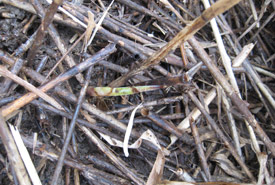
Shoot of alien species of phragmites poking through (Photo by Bill Moses)
Are you aware of the phragmites problem? We all know that at one time our native species thrived in a balanced ecosystem that is now being compromised by the rapid spread of some non-native plants. Phragmites australis (also known as common reed) is one of the worst offenders, forming colonies that cover wide areas and accumulate such a dense mat of litter that no other species can grow there. Even worse, it loves wetlands, where reside some of our most fragile and diverse ecosystems.
That said, it should be noted that our native variety (Phragmites australis v. americanus) co-exists happily with other species in its preferred wetland environment.
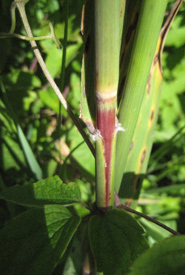
Close up of a Native phragmites shoot (Photo by Bill Moses)
It may be beyond the capacity of an individual to eradicate massive colonies (professionals with chemicals, burning capability and lots of money are better equipped to handle that), but remember that every huge colony started out as a small one. Although some people who have attempted to deal with small infestations have given up the task as hopeless, I propose that individuals can control smaller patches of phragmites, not necessarily by killing the plants, but by keeping them crippled. Admittedly, it's a long-term project but satisfying.
Anthropomorphization of the plant can add zest to the game. David might not be able to slay Goliath but keeping him on his knees leaves him harmless. (Take that, sucker!)
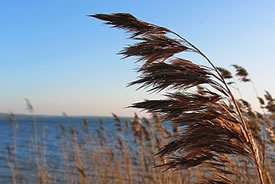
Phragmites (Photo by Wikimedia Commons)
In May of 2010, having just emerged victorious from a battle with periwinkle (Vinca minor) on a Nature Conservancy of Canada property in Chatsworth, Ontario, I turned my attention to a patch of Phragmites australis v. australis. It was (and still is) just down the road from my house.
How did phragmites come to be there? Our municipality had cleaned out the ditches so that water would not back up onto the roadway. Almost surely their equipment carried bits of root from somewhere else and deposited them on bare moist soil resulting in phragmites being inadvertently planted in ideal conditions. A new colony was born.
In dealing with invasives, one must consider how the plant propagates itself. Garlic mustard, for example, is a biennial that reproduces only from seed. Removing the flower heads before they go to seed provides some measure of control. Seeds can remain in the ground for several years (possibly up to 30) so it is necessary to remove the flowers each year; once you miss a year you have to start all over again.
Phragmites, however, is a perennial, and the entire plant, including the root system, must be removed. This is an almost impossible task since any piece of root left in the soil or carried someplace else has the potential to start a new colony (gardeners face the same problem with goutweed).
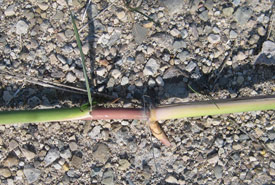
Alien species of phragmites creeping along the ground (Photo by Bill Moses)
In all the places I've seen the alien phragmites, it's pretty obvious that it was introduced by humans (usually unintentionally). Phragmites can reproduce from seed but is a rare enough event that a few years ago this method of reproduction was dismissed as insignificant. In my view, removing the flowers merely saves energy that the plant can then put into expanding the colony through its root system (apparently though, reproduction by seed is becoming a bigger and bigger problem due to increasing genetic diversity between individual plants).
I picture phragmites as a subterranean being with wants and needs. It wants to expand its colony, but it needs food and water. It gets its water underground by sending roots (rhizomes) out for several metres. However, even searching for water requires energy in the form of food. The plant's leaves (the food factory) produce food with the help of the sun (photosynthesis). The more leaves and the bigger the plant, the more food is produced and the greater is the potential for the colony to expand. Each time a leaf is removed, the plant has to expend energy to produce a new leaf. One can eliminate periwinkle in one or two years by depriving it of sunlight. However, it appears that phragmites has much bigger food reserves and greater tenacity.
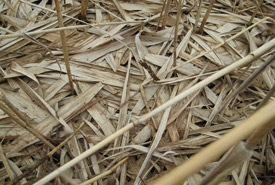
Phragmites pile (Photo by Bill Moses)
So how am I dealing with it? I started by cutting down the old stalks with ordinary old-fashioned garden shears. Now I cut down new growth with a grass whipper. As other species of plants emerge, I try not to damage them by cutting only the part of the phragmites that sticks up above the other plants. I also snap off individual plants as low as possible by hand. I spend 15 or 20 minutes at a time keeping the space pruned and I feel that I am (very) slowly moving toward victory.
One common belief is that if you cut off a plant at the base, five more will take its place. Therefore, cutting off the plant only makes the problem worse. While it is true that there will be sprouting from the root system, I look at it this way: the root system is the real enemy. It gets its food from the aboveground portion of the plant.
Every time you remove a plant (or leaves) you are depriving the root system of sustenance. All its stored energy then has to go towards producing new plants; with luck, there is no excess food that it can use to expand its area. As native plant competition flourishes, this also takes away sustenance from the plant.
The real secret, as with any weed, is to realize that this will be a long-term (perhaps endless) battle. Truth be told, once every month or so during the growing season, I return to the former periwinkle patch to spend a few minutes looking for periwinkle sprouts and I find a few almost every time.
It is my sincere hope that I have given you the courage to join in the battle against the further spread of this alien species.
This post originally appeared in the The Blazing Star (North American Native Plant Society's newsletter) and is republished with permission from the author and publisher.


